

PBL 3. PBL 2. Project-Based Learning. Effective Team-Working. Our section on Working in Groups and Teams, starting with What is a Group?

, defines groups and explains some of the issues and challenges of working in a group. It explains the Group Life-Cycle, and how groups can change over time. This page builds on those, and sets out some of the specific skills that you may need when working in a group or a team. Effective Teams Our page on Group Roles explains that there are a number of roles that any one person can take on in a team. In summary these are: Belbin’s Team Roles Research shows that the most effective teams have someone who can take on each of the nine key roles.
Teams that struggle to operate effectively, however, tend to lack one or more of the nine key roles. Task vs. Belbin’s team roles can be divided into Task and Process roles. Task roles focus on ‘what’: the job in hand, and getting it done. The most effective team-workers are those who can see what skills are available within the group, and use their own skills to fill any gaps. Project Based Teaching Practices: Assess Student Learning. Odissea: Log in to the site. 1819MI199006330500: Cooperative learning strategies - Kagan. Driving Questions. Creating a Driving Question. Putanendtohunger. Rattle your dags! Let's pack to Oz! Consejos para ser un experto en Sway. La primera fila ofrece un estilo único que combina filtros de imágenes, títulos elegantes y atrevidos, fondos, imágenes enmarcadas y alineación a la izquierda.
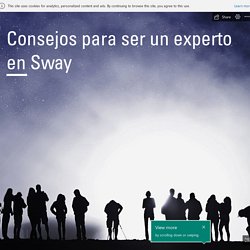
Con este estilo se pueden explorar diferentes tratamientos de imagen para buscar el que mejor se adapte al tono del sway. El segundo estilo ofrece un diseño pulcro y elegante, con imágenes y texto alineados al centro, y las imágenes colocadas una debajo de la otra. El tercer estilo hace un tratamiento sofisticado de títulos y fondos, enmarca las imágenes y alinea los elementos a la izquierda.
En este estilo, las imágenes se colocan en paralelo o una encima de la otra, en función del espacio disponible. El cuarto estilo muestra un diseño moderno con texto alineado a la izquierda. El quinto estilo ofrece un diseño atrevido, con una gran variedad de texturas de fondo, elementos decorativos de gran riqueza y una divertida interacción entre el contenido y el fondo.
Ideament on the App Store. Ideament lets you easily draw a diagram - mind map, concept map, or flow chart - and convert it to a text outline, and vice versa.

You can use Ideament for anything, such as brainstorming new ideas, illustrating concepts, making lists and outlines, planning presentations, creating organizational charts, and more! Create Ideas Instantly Copy text from another app, such as an email, document, or web page, and import it into Ideament to automatically create an idea. Share Your Ideas Diagrams and outlines can be easily shared via email or the cloud (Dropbox, Google Drive, OneDrive, Box) and copied directly into other apps. Diagrams can also be saved to the Photos app (to sync to your desktop) or uploaded to Facebook. Try It Out! Missió 0 - Introducció. Tripulacions!!

Inkarnate. 5 Free Assessment Apps for Teachers. Teachers are always looking for new ways to assess their students' work.
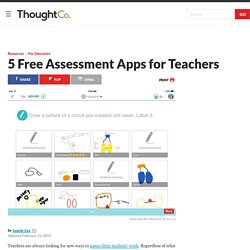
Regardless of what curriculum you teach, assessment is something that teachers must do every day, even informally. Thanks to the latest in mobile technology, assessing students' work has never been easier! Top 5 Assessment Apps Here are the top 5 assessment apps that will assist you in observing and assessing your students. Nearpod. Diez pasos para aplicar el aprendizaje basado en proyectos. El aprendizaje basado en proyectos es una metodología que permite a los alumnos adquirir los conocimientos y competencias clave en el siglo XXI mediante la elaboración de proyectos que dan respuesta a problemas de la vida real.
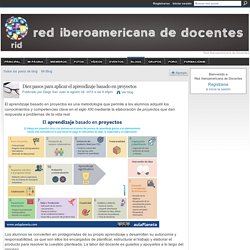
Los alumnos se convierten en protagonistas de su propio aprendizaje y desarrollan su autonomía y responsabilidad, ya que son ellos los encargados de planificar, estructurar el trabajo y elaborar el producto para resolver la cuestión planteada. La labor del docente es guiarlos y apoyarlos a lo largo del proceso. Selección del tema y planteamiento de la pregunta guía. The key ingredients for successful project-based learning [INFOGRAPHIC] Most people today live in a world of projects. No matter what we do for a living, work projects are everywhere. We need to do research and planning, work in teams, constantly adapt to feedback, all while trying to find the best solutions and keep within budgets.
And even life outside of work is full of projects. Whenever we need to bake a cake, plant a flower, paint a room, repair something around the house or organize a birthday party, we still need to do research and planning, communicate and collaborate with other people, constantly adapt to feedback and manage budgets. I think I made it clear by now that the adult life is full of projects. The education system is supposed to prepare students for the adult life. Flipping Your Teacher Training. 7 Steps To Flipped Professional Development by Laura Conley first appeared on gettingsmart.com Arriving home from San Diego and having just attended the ISTE (International Society of Technology in Education) conference I was scheduled to facilitate an all-day professional development for our district.
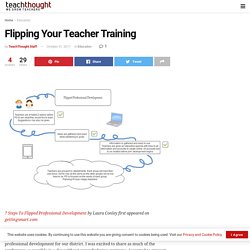
I was excited to share as much of the conference as possible in a day without overwhelming everyone. I wanted to present the information in an engaging way by modeling the use of technology instead of just handing everyone a sheet of paper with some links. The Definition Of Blended Learning. The Definition Of Blended Learning by TeachThought Staff Blended education.

Hybrid learning. 20 Questions To Clarify Your Teaching In 2019. 20 Questions To Clarify Your Teaching In 2019 by Terry Heick Who knows where education is going, but it’s not impossible to come up with some questions that might guide that evolution.
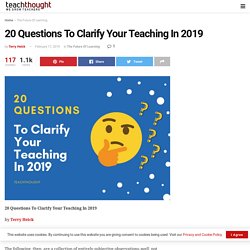
The following, then, are a collection of entirely subjective observations–well, not entirely subjective I guess. Or not any more than anyone else. We all see what we choose to see, and interpret it how we will. At TeachThought, I see a lot of ‘data.’ Traditional questions that teachers and administrators face exist–and will for the foreseeable future: How can we ‘move students’ from this performance level to that? Modern Trends In Education: 50 Different Approaches To Learning. Modern Trends In Education: 50 Different Approaches To Learning contributed by Lisa Chesser and updated by TeachThought Staff.
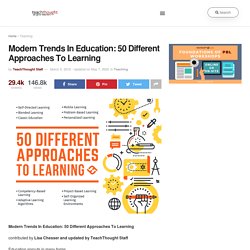
The Ultimate Guide To Flipping Your Classroom. Note: This is part 1. What is the Flipped Classroom? “A reversed teaching model that delivers instruction at home through interactive, teacher-created videos and moves “homework” to the classroom. Moving lectures outside of the classroom allows teachers to spend more 1:1 time with each student. Students have the opportunity to ask questions and work through problems with the guidance of their teachers and the support of their peers – creating a collaborative learning environment.”(1) 5 Digital Tools For The Flipped Classroom. Hafsa Wajeeh, dtopgadgets Have you “Flipped your classroom” yet? The flipped classroom is a useful technique that has moved lectures out of the class, and onto digital media.
In doing so, teachers can drastically increase interaction time with their students. It also creates two unique learning environments instead of just one, and opens up the opportunity for students to ask questions, solve problems, and use technology in a meaningful way. A number of tools are available that can be used to record lectures, including YouTube, Edmodo, Schoology, and Moodle. 7 Must-Have Tools For The Flipped Classroom.
7 Must-Have Tools For The Flipped Classroom by first appeared on gettingsmart.com The flipped classroom uses technology to allow students more time to apply knowledge and teachers more time for hands-on education. It’s a continually changing strategy that evolves with technology. Innovative educators are usually on the lookout for the latest technology breakthroughs that will help them better organize and conduct flipped classrooms. 6 Steps To A Flipped Classroom - By Josh Corbat Students today are vastly different from when we were in their shoes. We were brought up on the age-old tradition of lecture, practice, and assessment. Lather, rinse, repeat. Don’t get me wrong, students today were brought up in the same style. But, something is different.
Think about it. 3 Common Barriers To Success In A Flipped Classroom Model. By Saqib Hussain, Language Teacher In The Agenda with Steve Paikin: Higher Education at the Crossroads (April 15th, 2013), one of the guests, Richard DeMillo, referred to the Benjamin Bloom’s “Two-sigma problem,” claiming that with the move from the “sage on stage” model to the kind of learning technology now enables, it is now possible to move the performance of everyone to the 90th percentile. Bloom’s two-sigma problem refers to observations that Bloom and his graduate students made in the mid-eighties, where they showed that one-on-one tuition, combined with mastery learning (i.e. not allowing a student to progress to the next topic until the current topic has been completely understood), would move an average student (i.e. one who would ordinarily rank in the 50th percentile) up to the 98th percentile (in statistics speak, that’s two standard deviation, or two sigmas).
10 Pros And Cons Of A Flipped Classroom. 10 Pros And Cons Of A Flipped Classroom by Mike Acedo Many of us can recall instances in our lives where we found ourselves idly sitting in a classroom, eyes glazed over, half listening to our teacher as they lectured in front of the room. These scenes are all too familiar in today’s schools, as the traditional model of learning has primarily revolved around a teacher-centered classroom, where instructors focus on conveying information, assigning work, and leaving it to the students to master the material. Though effective for some, this type of instruction has forced students to be merely receptors of information, rather than participants in their own learning processes through active learning. Fortunately, as technology has increasingly grown and infiltrated our classrooms, a new learning model has emerged that moves away from a teacher-centered space, and onto a more collaborative, student-centered learning environment, by way of a flipped classroom.
4 Pillars & 11 Indicators Of Flipped Learning. 4 Pillars & 12 Standards Of Flipped Learning by Kari M. Arfstrom, Executive Director of the Flipped Learning Network Flipped Learning Defined 10 Common Misconceptions About The Flipped Classroom, by Kelly Walsh, offered some insight. Student Engagement in a Flipped Classroom. A Student-Led, Flipped, Inquiry-Based Learning Classroom Doing Authentic Work - 54 Flipped Classroom Tools For Teachers And Students -
The Teacher's Guide To Project-Based Learning. 10 Apps For More Organized Project-Based Learning. 11 Steps Of Effective Project-Based Learning In A Blended Classroom - In part 1 of this 6-part series, Thomas Stanley looked at an overview of blended learning, specifically the critical interactions of a blended learning model. In part 2, he looked specifically at student-to-student interaction, and the reality of synchronous and asynchronous access. 3 Ways To Use Vine In The Project-Based Learning Classroom - The Difference Between Doing Projects Versus Learning Through Projects. 7 Essential Ingredients Of Project-Based Learning.
Using The QFT To Drive Inquiry In Project-Based Learning - 5 Characteristics Of Project-Based Learning That Works - 6 Ways Teachers Are Using Blended Learning. 8 Switches To Update Project-Based Learning In The 21st Century - Spotlight: Student Work In Project-Based Learning - 5 Tips For Integrating Project-Based Learning In Any Content Area - Using Project-Based Learning To Flip Bloom’s Taxonomy For Deeper Learning - 8 Basic Steps Of Project-Based Learning To Get You Started - How Do I Differentiate Through Project-Based Learning? - 4 Things All Project-Based Learning Teachers Should Do - 5 Powerful Teaching Strategies For Project-Based Learning - 8 Things I Learned My First Year Of Teaching With Project-Based Learning - A Project-Based Learning Cheat Sheet For Authentic Learning. Are Students Doing Projects Or Learning Through Project-Based Learning? - 10 Conversations That Can Launch Project-Based Learning. 3 Ways To Differentiate In Project-Based Learning -
12 Myths About Project-Based Learning - 5 Ideal Traits Of A Project-Based Learning Teacher - 4 Keys To Designing A Project-Based Learning Classroom - 11 Essential Tools For Better Project-Based Learning. 3 Types Of Project-Based Learning Symbolize Its Evolution. The Difference Between Projects And Project-Based Learning. A Better List Of Ideas For Project-Based Learning. 13 Brilliant Outcomes Of Project-Based Learning - 8 Needs For Project-Based Learning In The 21st Century. 16 Questions To Help Students Brainstorm Project-Based Learning. 23 Ways To Use The iPad In The 21st Century PBL Classroom By Workflow. A Project-Based Learning Spectrum: 25 Questions To Guide Your PBL Planning. 5 Reasons Why PBL May Not Be Working At Your School - 6 Tips For PBL Planning Across Content Areas - To PBL or NOT TO PBL (Is that the correct Question?) – Off Road Edu Adventures.
Projects Vs Project Based Learning: What is the difference? – Off Road Edu Adventures.